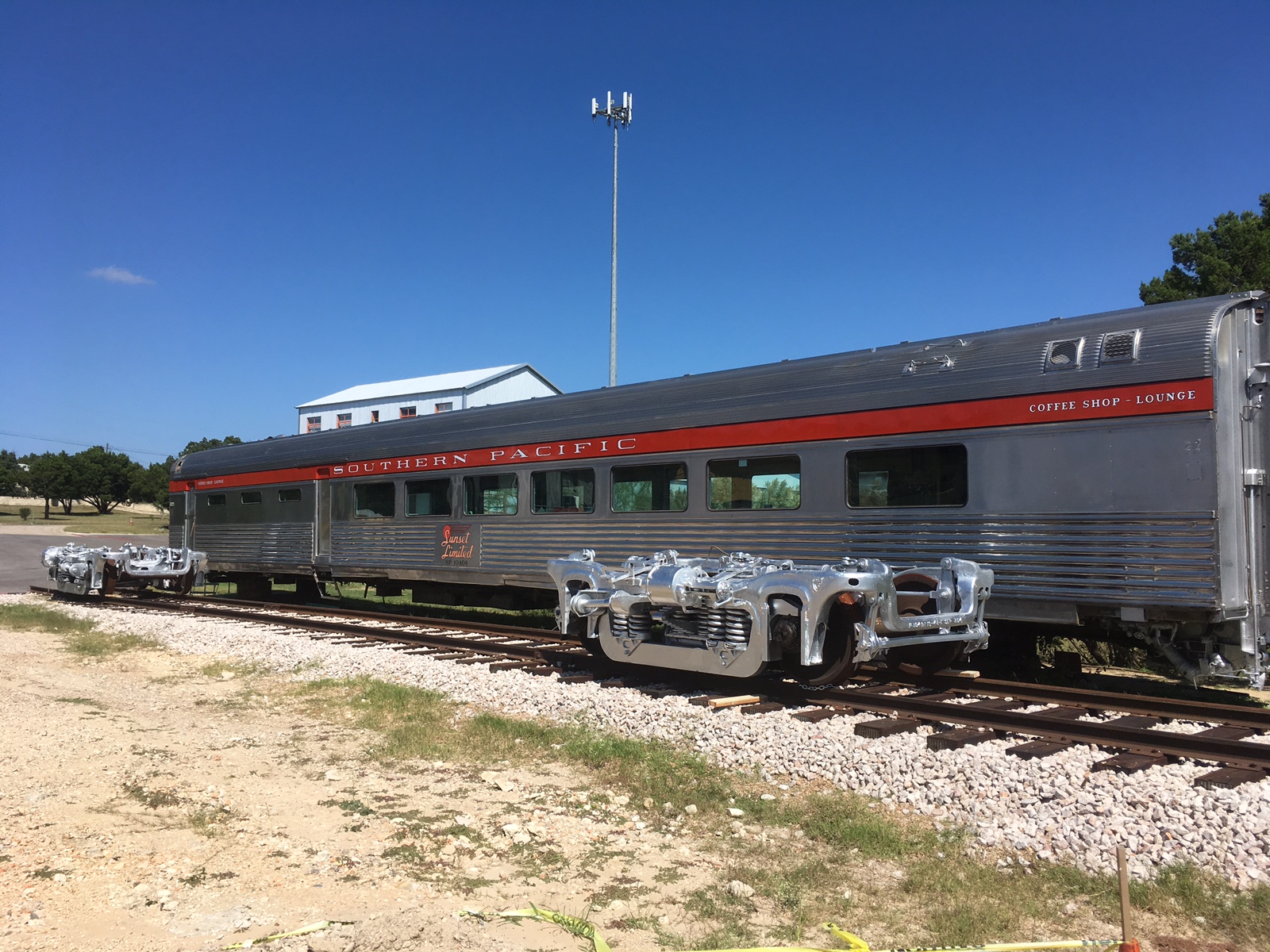
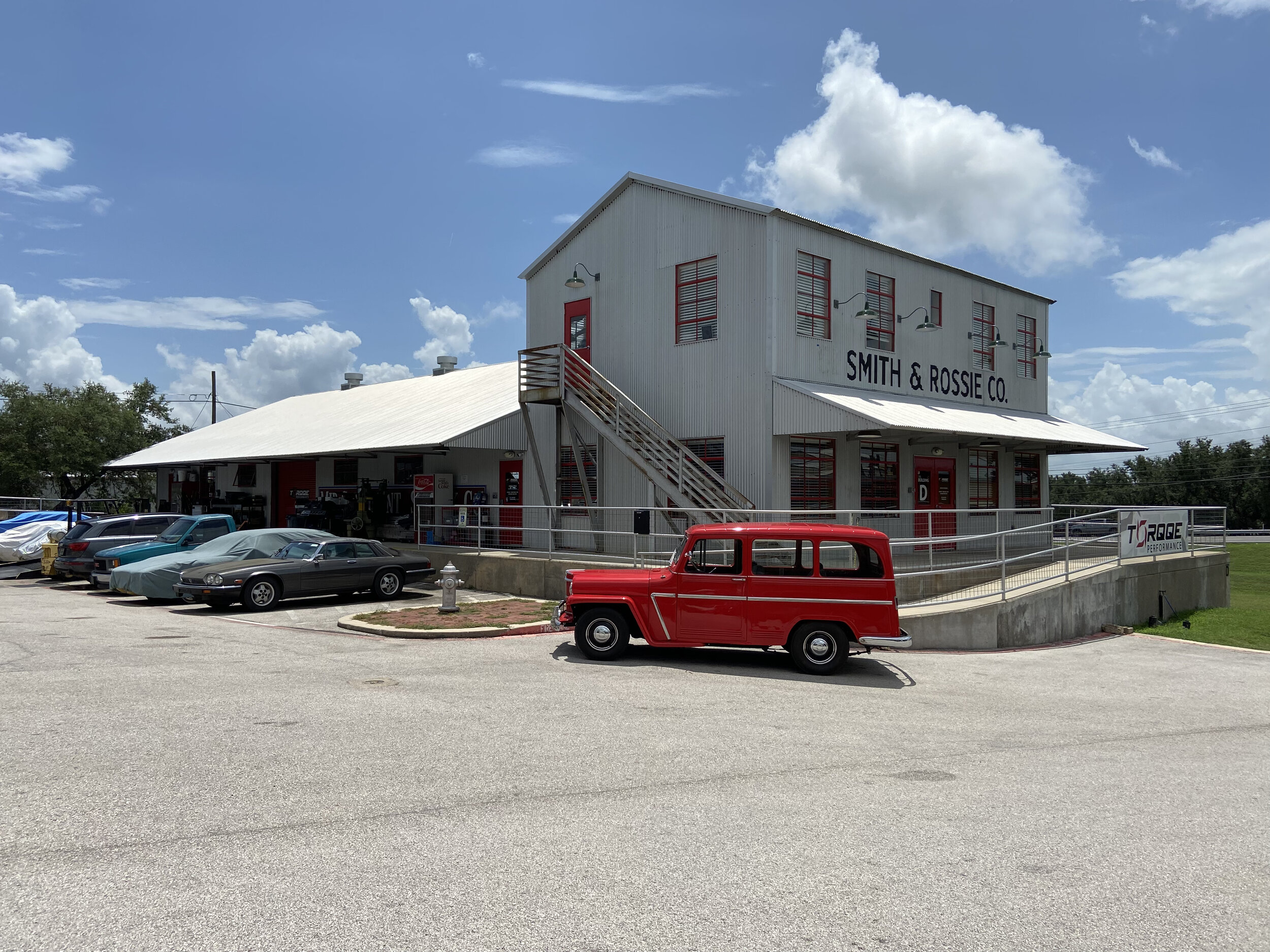


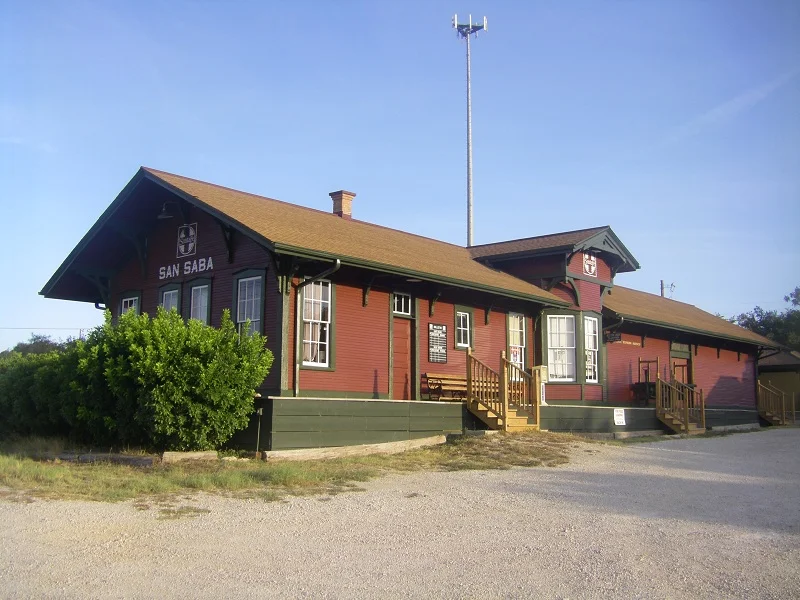


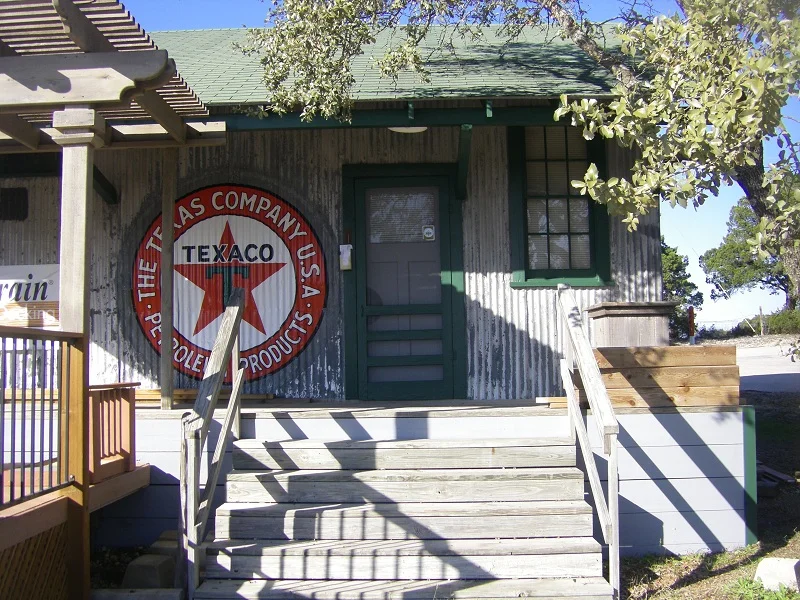


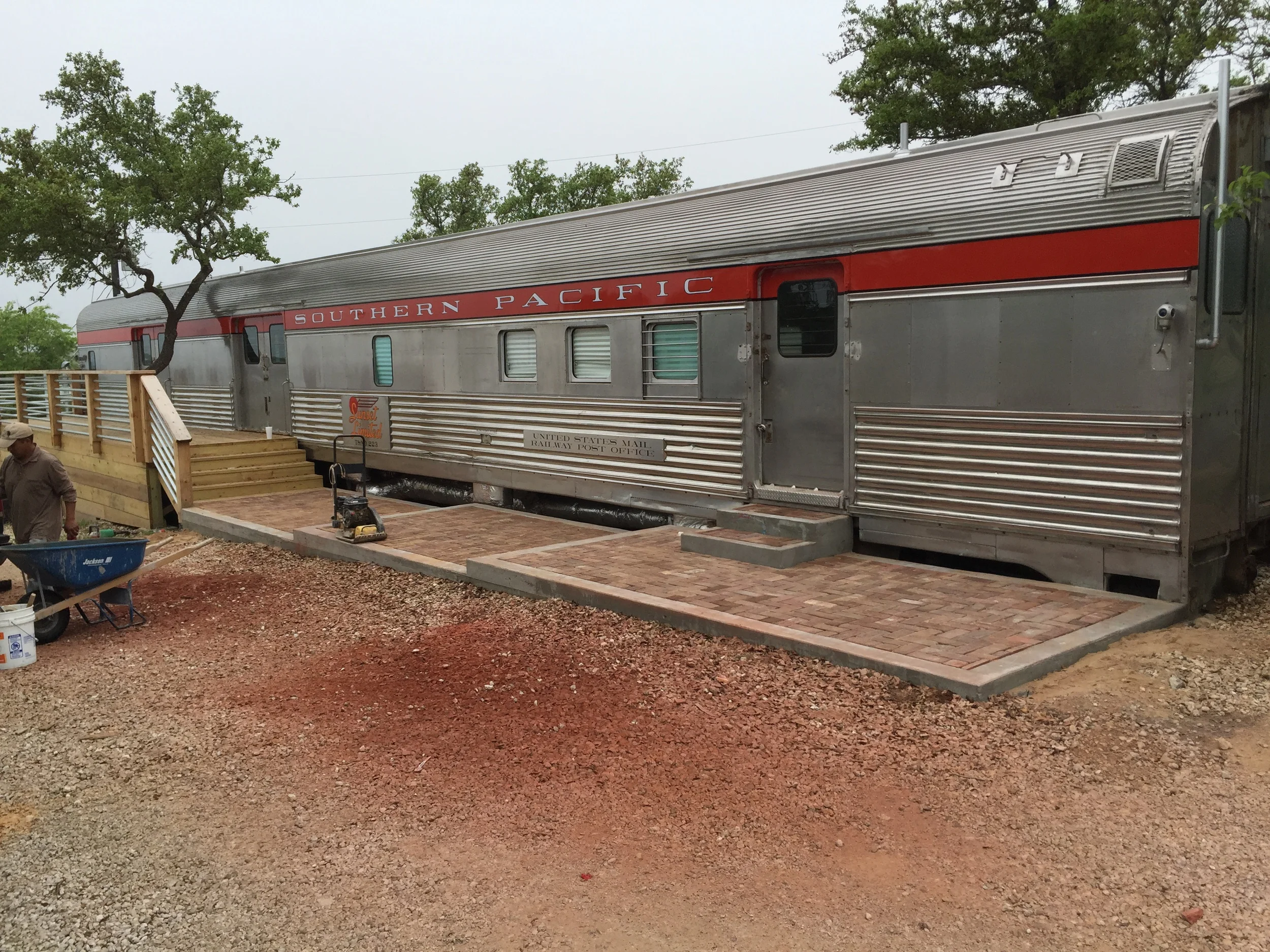
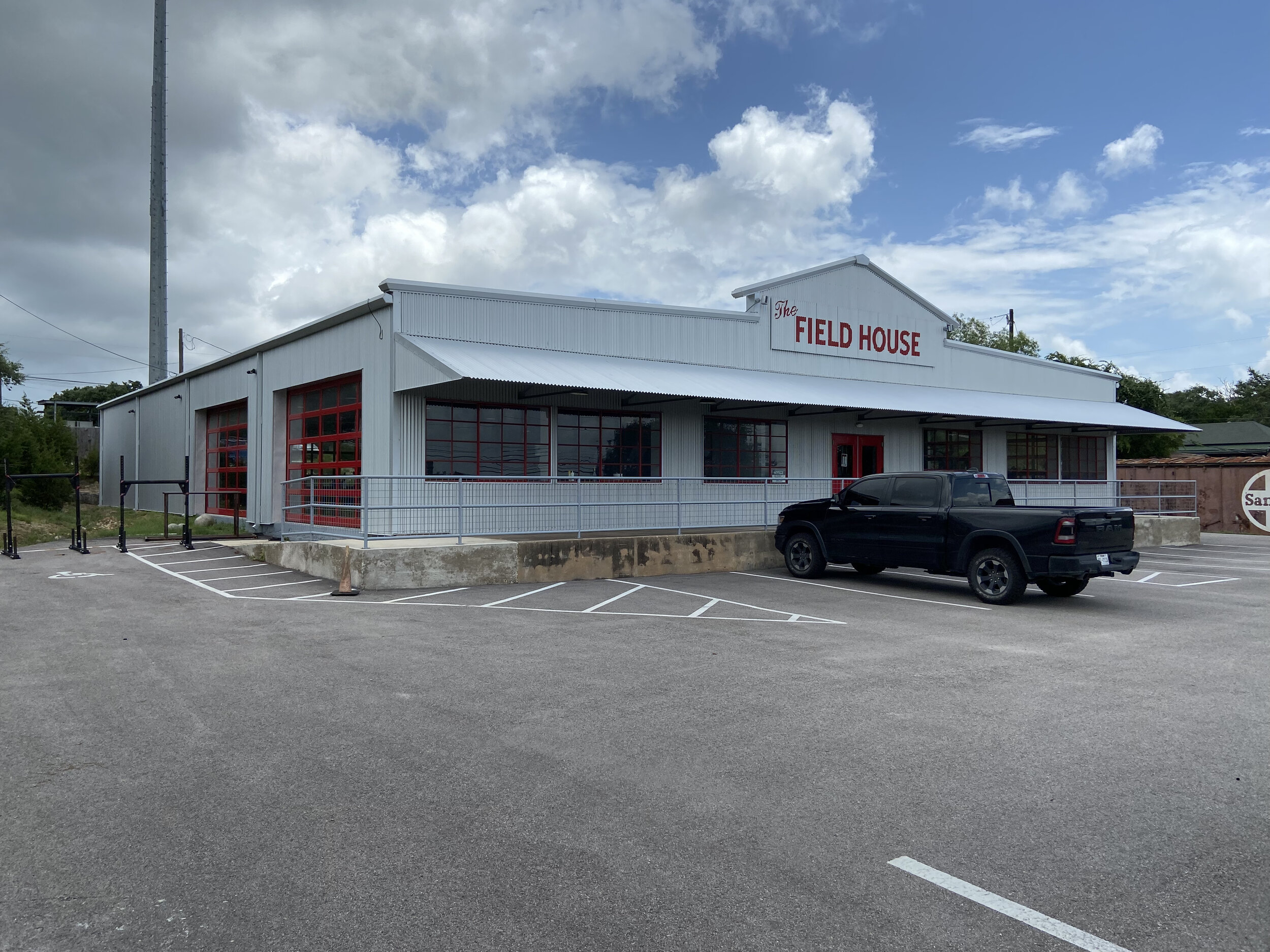

The Texas Compound is a real estate development project anticipated to require fifty years for completion. The project commenced in 1984 with the acquisition of a Santa Fe Railroad Depot at San Saba, Texas which was set for retirement and demolition. This building was purchased from the Atchison, Topeka, and Santa Fe Depot for $1 per square foot and moved to 9120 Highway 290 West, Austin, Texas, in the summer of 1986. At that time this location was out in the country, far beyond the Austin city limits. Later acquisitions included smaller Santa Fe outbuildings from Coleman, Cleburne, Sagnor and Barnhart along with box cars obtained from Cameron and Miami, Texas. These railroad structures have been leased continuously since 1986 to a Purina Feed dealer.
In later years, additional acreage was purchased in the same block, to the west, and the project has continued with the addition of other West Texas structures rescued from demolition. Later acquisitions include the Santa Fe Railroad Depot from Dumas, the United Oilfield Supply warehouse from Snyder, the National Oilfield Supply warehouse from Midkiff, the Texaco bulk fuel warehouses from McCamey and Spur, three "Texas Zephyr" Railroad passenger cars, and two Southern Pacific "Sunset Limited" passenger cars.
A Travis County site development permit has been approved to enable the location and restoration on vacant acreage to the immediate west of more West Texas structures to be rescued in the years ahead.
Thematically, this project represents the world of men at work in West Texas between 1900 and 1950. All of the structures and railroad cars are restored for lease to commercial tenants.
Description
Description
Building description
Description
The Atchison, Topeka & Santa Fe Railroad Company reached Texas in 1886 with the purchase of the then independent (but coincidentally named) Gulf, Colorado & Santa Fe Railway Company, adding some 1000 main track miles to the Santa Fe System. A provision of the State's Constitution required that railway companies doing business in Texas maintain general offices within the state, for which purpose the Santa Fe maintained two subsidiary corporations until 1965, the G.C.&S.F. headquartered in Galveston and the P.&S.F. headquartered in Amarillo. The G.C.&S.F. operated Texas mileage east of Sweetwater, Sterling City, and Menard, along with all Louisiana mileage and all Oklahoma points south of Purcell, which was the meeting point when the A.T.&S.F. purchase was consummated.
The G.C.&S.F. was commonly referred to as the "Gulf Lines" or Gulf Division. The company fielded a peak number of open agencies in 1912, when 176 agents were on the payroll. On June 30, 1912 it reported to the Railroad Commission of Texas the existence of 8089 employees, and the operation of 1596 main track miles. The G.C.&S.F. lost its independence as a subsidiary corporation with a separate general office and general manager in 1965, when it and the P.&S.F. were dissolved and absorbed into the A.T.&S.F. system. President Ernest S. Marsh, in a letter to affected employees, attributed the dissolution to technological advances enabling the centralized administration of operations and the need to make economies in corporate expenses. This refrain would later become familiar throughout corporate America.
At the time of the 1965 merger, there remained open a number of agencies which had been active since the G.C.&S.F. first opened service. Among these a very few survived into the 1980s before closure, of which at least 18 can be reckoned to have been open for at least 100 years, some in relatively isolated locales. These were at Bellville, Brenham, Caldwell, Cleburne, Clifton, Dallas, Fort Worth, Houston, Killeen, Lampasas, Lometa, McGregor, Midlothian, Milano, Rosenberg, Temple, Sealy and Somerville. Except in the larger cities, most of these agencies, when opened and for perhaps 20 years thereafter, represented the first and only national corporate employer in the communities served. The owner of this compound is at work on a history of the company’s Texas operations, see www.texassantafehistory.com for more information.
The depot was built in San Saba, Texas in 1911 by the Gulf, Colorado and Santa Fe Railway Co. It was constructed as a freight depot, the passenger depot being a separate brick building immediately adjacent. In addition to the two depots, the Santa Fe maintained at San Saba two section crew houses, a water tower for steam locomotives, livestock pens and scales, and assorted tool and coal houses. All of these are gone now and the railroad branch line, which formerly ran from Lometa west to Eden, Texas now terminates 25 miles west of San Saba at Brady. Passenger service at San Saba ended in 1958, and the brick depot was subsequently demolished. The freight agency and Western Union office survived in the freight depot until discontinuance was authorized by the Texas Railroad Commission on December 28, 1976 on the basis of declining revenues. During its final two years, the San Saba freight agency received and forwarded an average of only 39 freight cars per month. Station revenue for the period was $257,801.98, and station expenses were $33,413.17. System operating expenses attributed against the station for this period were $197,232.46.
From 1977 to 1985 the depot was used for storage by maintenance-of-way crews. It was sold to the current owner in 1985 on the condition that it be removed from the premises. A set of standard Santa Fe blueprints drawn in Galveston in 1906 was used to make the one change accomplished during the restoration, which involved the finish-out and addition of windows to the middle room. Originally this room was another freight storage room identical to the one remaining, but in restoration it has been upgraded to match Santa Fe standards for a branch line combination passenger and freight station. This is in keeping with a standard Santa Fe practice of upgrading (or downgrading) a depot to meet the demands of a changing population. There were extremely few Santa Fe depots that were not remodeled by the addition or deletion of rooms or entire portions during their service life. During the restoration of this depot, the passenger depot at Justin, Texas (north of Fort Worth) was being demolished. A number of items were salvaged just ahead of the wrecking ball and used in the restoration and finishout of the San Saba depot, including the exterior bay window trim, bay window agent's telegraph counters, front door and ticket counter and cabinets. Other items came from various Santa Fe depots and warehouses, most now demolished.
The structure behind the depot is the Signal Maintainer's Toolhouse from Coleman, Texas (between Brownwood and Sweetwater). It was built in 1946 as one of six identical structures across the Gulf Division, and was moved here in 1990 after retirement by the Santa Fe. The small hexagonal building to the east of the depot is the telegraph booth from Barnhart, Texas (west of San Angelo). Barnhart is located on the Kansas City, Mexico & Orient line, which was purchased by the Santa Fe in the late 1920s. The age of the structure is unknown. The red boxcar was built in 1964 and retired in 1986. It was purchased from the Santa Fe tracks at Cameron, Texas. The yellow boxcar is a much older refrigerator car, dating to the 1920s. The structure near the back of the lot is the Line Maintainer's toolhouse from Cleburne, Texas. It was built in 1916, and appears to have been custom designed for its purpose as there are no records of any other similar structures across the division. It is much taller than the standard toolhouses, and was moved here in 1992 after retirement by the Santa Fe. On the east side of the lot is the Signal Maintainer's toolhouse from Sanger, Texas (north of Fort Worth). It was built in 1920, and is similar in appearance to the Coleman toolhouse.
Description
Description
The Texaco warehouse at the rear of the lot was built in Spur, Texas in 1928 and that company opened its agency in the building on January 4, 1929. Spur is located about 70 miles east of Lubbock, and this structure sat at the very end of the line of the Stamford & Northwestern Railroad, which reached the community in 1909. This rail line would become a part of the Burlington Line System in later years. The warehouse was built to receive bulk shipments of gasoline, kerosene and lubricating oil, all delivered by rail at a time when there were no paved roads serving the community, and was one of more than 2000 local agencies serving what was then called “The Texas Company” but later known simply as “Texaco”. The primary customers of this agency included many large ranches in the area. Within 50 years the agency would close, a victim of the same consolidation seen by the railroads, and the building sat vacant for 20 years until moved here in 1999.
Description
Description